NURS20024: Nursing Practice 4 Assignment - Myocardial Infarction
VerifiedAdded on 2022/09/17
|14
|4053
|33
Homework Assignment
AI Summary
This document presents a completed nursing assignment focusing on a case study of a patient experiencing a myocardial infarction (MI). The assignment addresses various aspects of patient care, including the interpretation of ECG results to determine the location of the infarction, which is identified as the right coronary artery. It explores laboratory parameters such as Troponin T & I, and CPK-MB tests, and discusses the use of medications like nitroglycerin, heparin, amiodarone, beta-blockers, and aspirin. The assignment analyzes vital signs, including blood pressure and pulse, and outlines appropriate clinical responses to the patient's condition, such as stopping certain medications. It also covers interventions like PCI (percutaneous coronary intervention), pre- and post-procedure nursing management, and potential complications like chest pain. The assignment further includes an ECG interpretation, and a discussion on patient discharge planning, emphasizing the importance of a healthy lifestyle and dietary adjustments. The student also discusses the placement of ECG leads and provides an analysis of the patient's ECG, including heart rate and rhythm. The assignment demonstrates a comprehensive understanding of MI management and nursing interventions.
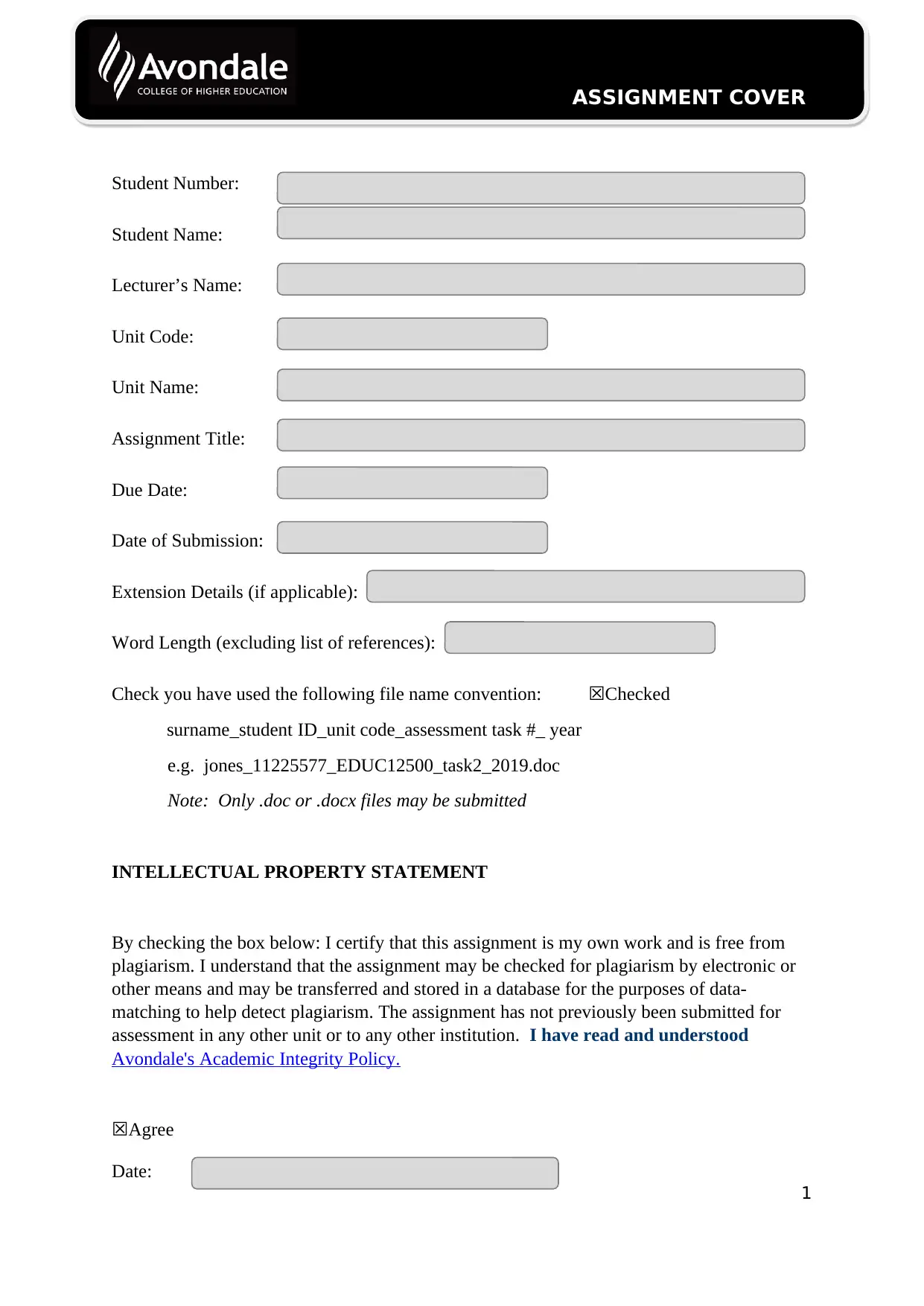
Student Number:
Student Name:
Lecturer’s Name:
Unit Code:
Unit Name:
Assignment Title:
Due Date:
Date of Submission:
Extension Details (if applicable):
Word Length (excluding list of references):
Check you have used the following file name convention: ☒Checked
surname_student ID_unit code_assessment task #_ year
e.g. jones_11225577_EDUC12500_task2_2019.doc
Note: Only .doc or .docx files may be submitted
INTELLECTUAL PROPERTY STATEMENT
By checking the box below: I certify that this assignment is my own work and is free from
plagiarism. I understand that the assignment may be checked for plagiarism by electronic or
other means and may be transferred and stored in a database for the purposes of data-
matching to help detect plagiarism. The assignment has not previously been submitted for
assessment in any other unit or to any other institution. I have read and understood
Avondale's Academic Integrity Policy.
☒Agree
Date:
1
ASSIGNMENT COVER
PAGE
Student Name:
Lecturer’s Name:
Unit Code:
Unit Name:
Assignment Title:
Due Date:
Date of Submission:
Extension Details (if applicable):
Word Length (excluding list of references):
Check you have used the following file name convention: ☒Checked
surname_student ID_unit code_assessment task #_ year
e.g. jones_11225577_EDUC12500_task2_2019.doc
Note: Only .doc or .docx files may be submitted
INTELLECTUAL PROPERTY STATEMENT
By checking the box below: I certify that this assignment is my own work and is free from
plagiarism. I understand that the assignment may be checked for plagiarism by electronic or
other means and may be transferred and stored in a database for the purposes of data-
matching to help detect plagiarism. The assignment has not previously been submitted for
assessment in any other unit or to any other institution. I have read and understood
Avondale's Academic Integrity Policy.
☒Agree
Date:
1
ASSIGNMENT COVER
PAGE
Paraphrase This Document
Need a fresh take? Get an instant paraphrase of this document with our AI Paraphraser
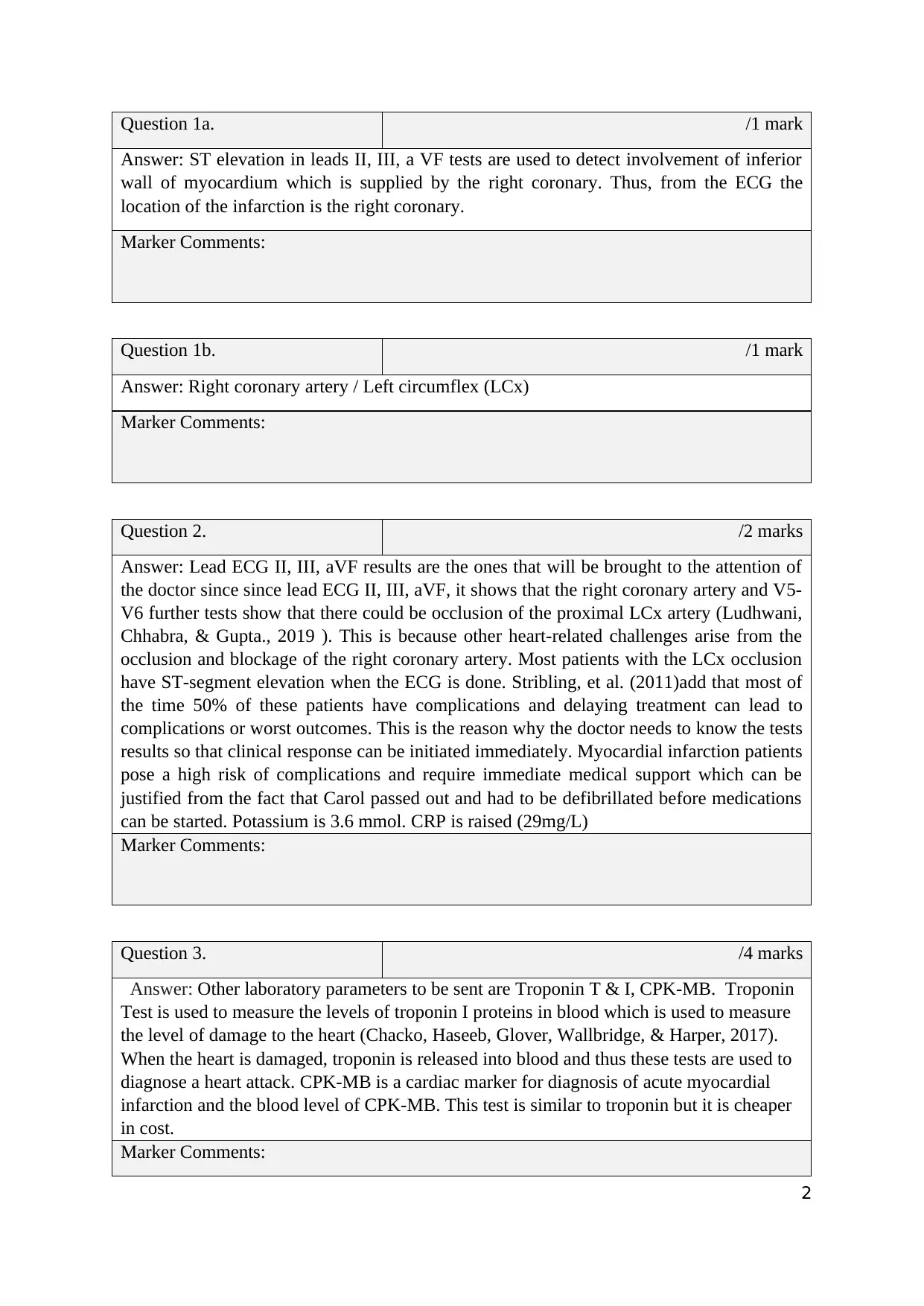
Question 1a. /1 mark
Answer: ST elevation in leads II, III, a VF tests are used to detect involvement of inferior
wall of myocardium which is supplied by the right coronary. Thus, from the ECG the
location of the infarction is the right coronary.
Marker Comments:
Question 1b. /1 mark
Answer: Right coronary artery / Left circumflex (LCx)
Marker Comments:
Question 2. /2 marks
Answer: Lead ECG II, III, aVF results are the ones that will be brought to the attention of
the doctor since since lead ECG II, III, aVF, it shows that the right coronary artery and V5-
V6 further tests show that there could be occlusion of the proximal LCx artery (Ludhwani,
Chhabra, & Gupta., 2019 ). This is because other heart-related challenges arise from the
occlusion and blockage of the right coronary artery. Most patients with the LCx occlusion
have ST-segment elevation when the ECG is done. Stribling, et al. (2011)add that most of
the time 50% of these patients have complications and delaying treatment can lead to
complications or worst outcomes. This is the reason why the doctor needs to know the tests
results so that clinical response can be initiated immediately. Myocardial infarction patients
pose a high risk of complications and require immediate medical support which can be
justified from the fact that Carol passed out and had to be defibrillated before medications
can be started. Potassium is 3.6 mmol. CRP is raised (29mg/L)
Marker Comments:
Question 3. /4 marks
Answer: Other laboratory parameters to be sent are Troponin T & I, CPK-MB. Troponin
Test is used to measure the levels of troponin I proteins in blood which is used to measure
the level of damage to the heart (Chacko, Haseeb, Glover, Wallbridge, & Harper, 2017).
When the heart is damaged, troponin is released into blood and thus these tests are used to
diagnose a heart attack. CPK-MB is a cardiac marker for diagnosis of acute myocardial
infarction and the blood level of CPK-MB. This test is similar to troponin but it is cheaper
in cost.
Marker Comments:
2
Answer: ST elevation in leads II, III, a VF tests are used to detect involvement of inferior
wall of myocardium which is supplied by the right coronary. Thus, from the ECG the
location of the infarction is the right coronary.
Marker Comments:
Question 1b. /1 mark
Answer: Right coronary artery / Left circumflex (LCx)
Marker Comments:
Question 2. /2 marks
Answer: Lead ECG II, III, aVF results are the ones that will be brought to the attention of
the doctor since since lead ECG II, III, aVF, it shows that the right coronary artery and V5-
V6 further tests show that there could be occlusion of the proximal LCx artery (Ludhwani,
Chhabra, & Gupta., 2019 ). This is because other heart-related challenges arise from the
occlusion and blockage of the right coronary artery. Most patients with the LCx occlusion
have ST-segment elevation when the ECG is done. Stribling, et al. (2011)add that most of
the time 50% of these patients have complications and delaying treatment can lead to
complications or worst outcomes. This is the reason why the doctor needs to know the tests
results so that clinical response can be initiated immediately. Myocardial infarction patients
pose a high risk of complications and require immediate medical support which can be
justified from the fact that Carol passed out and had to be defibrillated before medications
can be started. Potassium is 3.6 mmol. CRP is raised (29mg/L)
Marker Comments:
Question 3. /4 marks
Answer: Other laboratory parameters to be sent are Troponin T & I, CPK-MB. Troponin
Test is used to measure the levels of troponin I proteins in blood which is used to measure
the level of damage to the heart (Chacko, Haseeb, Glover, Wallbridge, & Harper, 2017).
When the heart is damaged, troponin is released into blood and thus these tests are used to
diagnose a heart attack. CPK-MB is a cardiac marker for diagnosis of acute myocardial
infarction and the blood level of CPK-MB. This test is similar to troponin but it is cheaper
in cost.
Marker Comments:
2
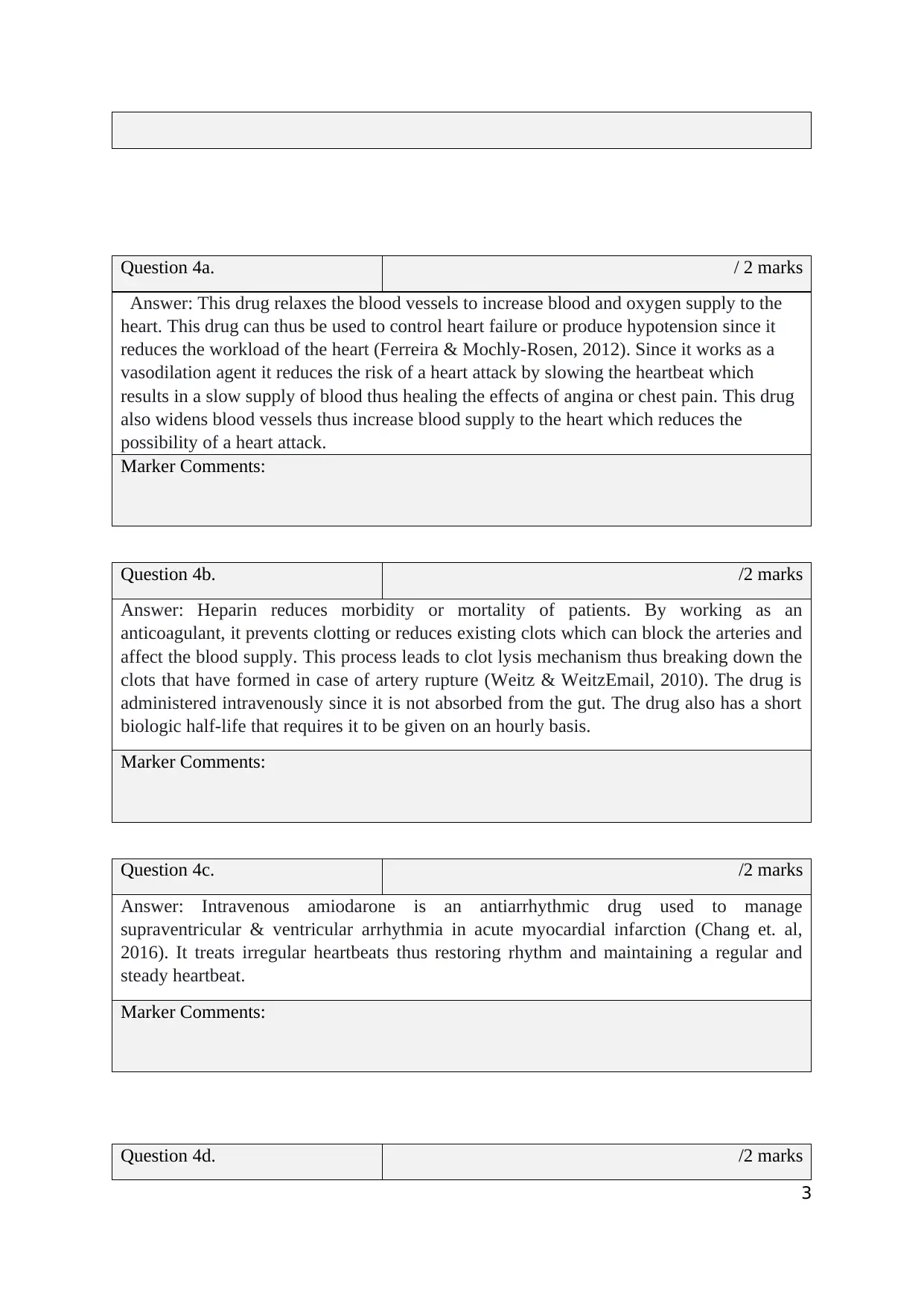
Question 4a. / 2 marks
Answer: This drug relaxes the blood vessels to increase blood and oxygen supply to the
heart. This drug can thus be used to control heart failure or produce hypotension since it
reduces the workload of the heart (Ferreira & Mochly-Rosen, 2012). Since it works as a
vasodilation agent it reduces the risk of a heart attack by slowing the heartbeat which
results in a slow supply of blood thus healing the effects of angina or chest pain. This drug
also widens blood vessels thus increase blood supply to the heart which reduces the
possibility of a heart attack.
Marker Comments:
Question 4b. /2 marks
Answer: Heparin reduces morbidity or mortality of patients. By working as an
anticoagulant, it prevents clotting or reduces existing clots which can block the arteries and
affect the blood supply. This process leads to clot lysis mechanism thus breaking down the
clots that have formed in case of artery rupture (Weitz & WeitzEmail, 2010). The drug is
administered intravenously since it is not absorbed from the gut. The drug also has a short
biologic half-life that requires it to be given on an hourly basis.
Marker Comments:
Question 4c. /2 marks
Answer: Intravenous amiodarone is an antiarrhythmic drug used to manage
supraventricular & ventricular arrhythmia in acute myocardial infarction (Chang et. al,
2016). It treats irregular heartbeats thus restoring rhythm and maintaining a regular and
steady heartbeat.
Marker Comments:
Question 4d. /2 marks
3
Answer: This drug relaxes the blood vessels to increase blood and oxygen supply to the
heart. This drug can thus be used to control heart failure or produce hypotension since it
reduces the workload of the heart (Ferreira & Mochly-Rosen, 2012). Since it works as a
vasodilation agent it reduces the risk of a heart attack by slowing the heartbeat which
results in a slow supply of blood thus healing the effects of angina or chest pain. This drug
also widens blood vessels thus increase blood supply to the heart which reduces the
possibility of a heart attack.
Marker Comments:
Question 4b. /2 marks
Answer: Heparin reduces morbidity or mortality of patients. By working as an
anticoagulant, it prevents clotting or reduces existing clots which can block the arteries and
affect the blood supply. This process leads to clot lysis mechanism thus breaking down the
clots that have formed in case of artery rupture (Weitz & WeitzEmail, 2010). The drug is
administered intravenously since it is not absorbed from the gut. The drug also has a short
biologic half-life that requires it to be given on an hourly basis.
Marker Comments:
Question 4c. /2 marks
Answer: Intravenous amiodarone is an antiarrhythmic drug used to manage
supraventricular & ventricular arrhythmia in acute myocardial infarction (Chang et. al,
2016). It treats irregular heartbeats thus restoring rhythm and maintaining a regular and
steady heartbeat.
Marker Comments:
Question 4d. /2 marks
3
⊘ This is a preview!⊘
Do you want full access?
Subscribe today to unlock all pages.

Trusted by 1+ million students worldwide
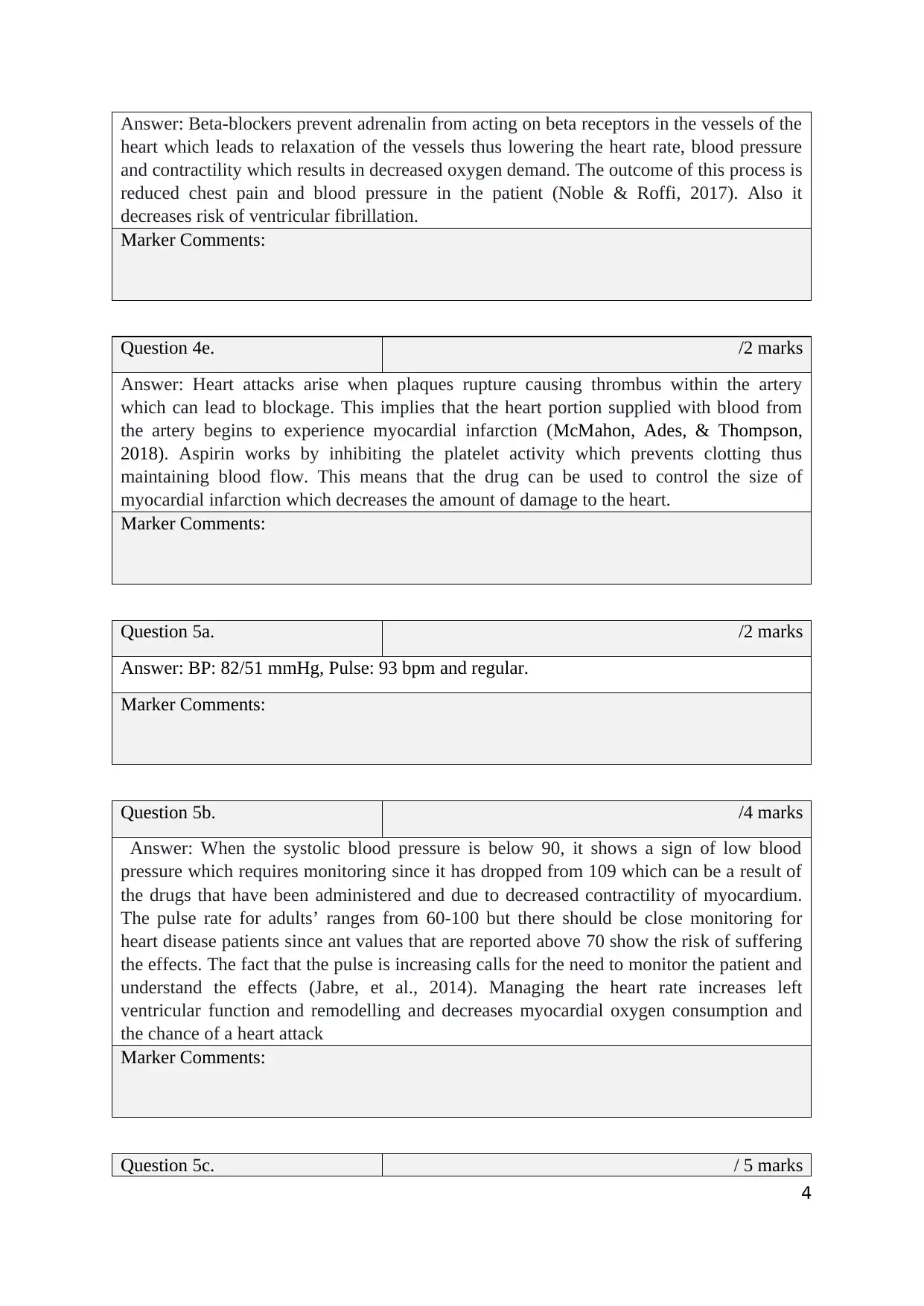
Answer: Beta-blockers prevent adrenalin from acting on beta receptors in the vessels of the
heart which leads to relaxation of the vessels thus lowering the heart rate, blood pressure
and contractility which results in decreased oxygen demand. The outcome of this process is
reduced chest pain and blood pressure in the patient (Noble & Roffi, 2017). Also it
decreases risk of ventricular fibrillation.
Marker Comments:
Question 4e. /2 marks
Answer: Heart attacks arise when plaques rupture causing thrombus within the artery
which can lead to blockage. This implies that the heart portion supplied with blood from
the artery begins to experience myocardial infarction (McMahon, Ades, & Thompson,
2018). Aspirin works by inhibiting the platelet activity which prevents clotting thus
maintaining blood flow. This means that the drug can be used to control the size of
myocardial infarction which decreases the amount of damage to the heart.
Marker Comments:
Question 5a. /2 marks
Answer: BP: 82/51 mmHg, Pulse: 93 bpm and regular.
Marker Comments:
Question 5b. /4 marks
Answer: When the systolic blood pressure is below 90, it shows a sign of low blood
pressure which requires monitoring since it has dropped from 109 which can be a result of
the drugs that have been administered and due to decreased contractility of myocardium.
The pulse rate for adults’ ranges from 60-100 but there should be close monitoring for
heart disease patients since ant values that are reported above 70 show the risk of suffering
the effects. The fact that the pulse is increasing calls for the need to monitor the patient and
understand the effects (Jabre, et al., 2014). Managing the heart rate increases left
ventricular function and remodelling and decreases myocardial oxygen consumption and
the chance of a heart attack
Marker Comments:
Question 5c. / 5 marks
4
heart which leads to relaxation of the vessels thus lowering the heart rate, blood pressure
and contractility which results in decreased oxygen demand. The outcome of this process is
reduced chest pain and blood pressure in the patient (Noble & Roffi, 2017). Also it
decreases risk of ventricular fibrillation.
Marker Comments:
Question 4e. /2 marks
Answer: Heart attacks arise when plaques rupture causing thrombus within the artery
which can lead to blockage. This implies that the heart portion supplied with blood from
the artery begins to experience myocardial infarction (McMahon, Ades, & Thompson,
2018). Aspirin works by inhibiting the platelet activity which prevents clotting thus
maintaining blood flow. This means that the drug can be used to control the size of
myocardial infarction which decreases the amount of damage to the heart.
Marker Comments:
Question 5a. /2 marks
Answer: BP: 82/51 mmHg, Pulse: 93 bpm and regular.
Marker Comments:
Question 5b. /4 marks
Answer: When the systolic blood pressure is below 90, it shows a sign of low blood
pressure which requires monitoring since it has dropped from 109 which can be a result of
the drugs that have been administered and due to decreased contractility of myocardium.
The pulse rate for adults’ ranges from 60-100 but there should be close monitoring for
heart disease patients since ant values that are reported above 70 show the risk of suffering
the effects. The fact that the pulse is increasing calls for the need to monitor the patient and
understand the effects (Jabre, et al., 2014). Managing the heart rate increases left
ventricular function and remodelling and decreases myocardial oxygen consumption and
the chance of a heart attack
Marker Comments:
Question 5c. / 5 marks
4
Paraphrase This Document
Need a fresh take? Get an instant paraphrase of this document with our AI Paraphraser
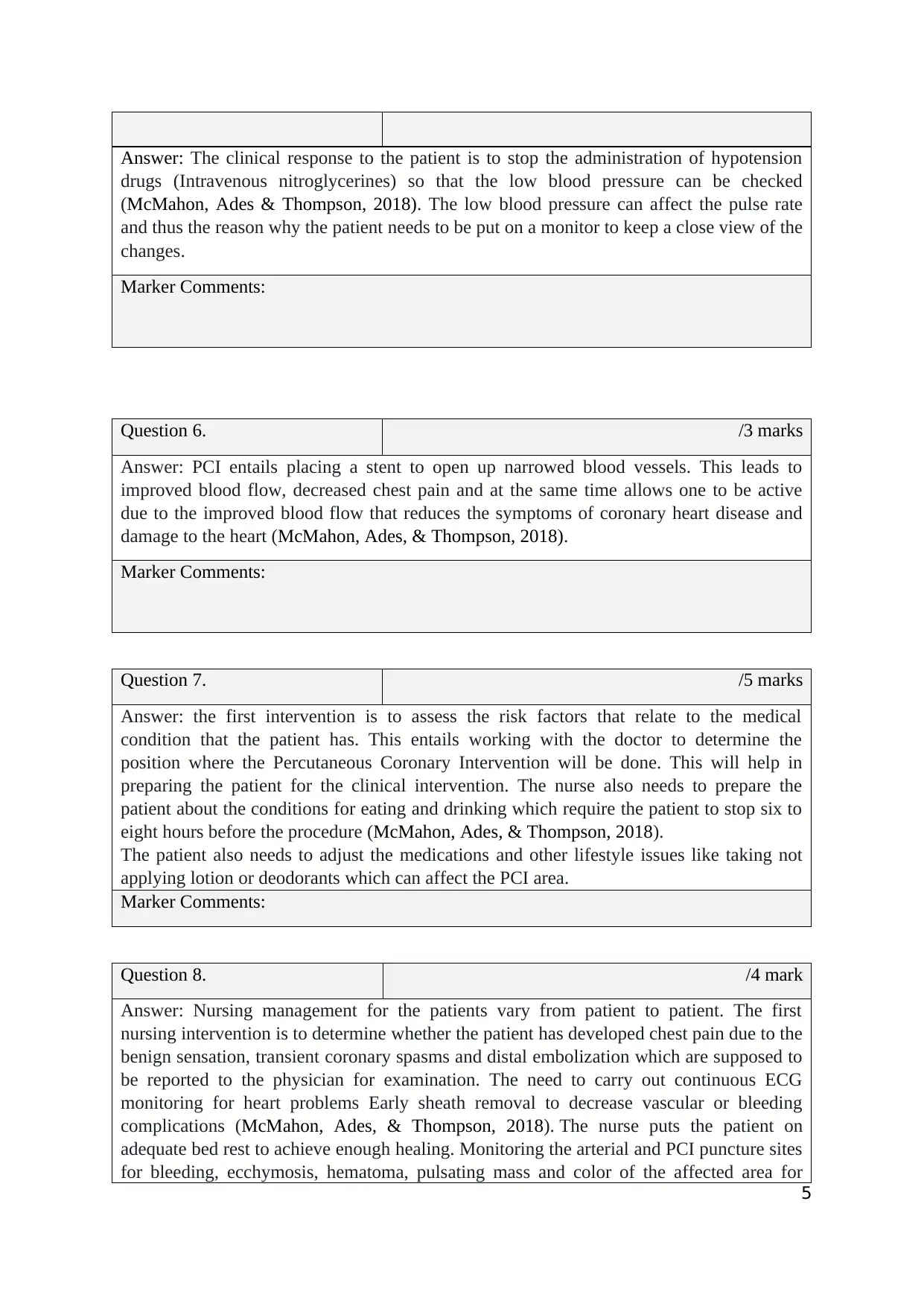
Answer: The clinical response to the patient is to stop the administration of hypotension
drugs (Intravenous nitroglycerines) so that the low blood pressure can be checked
(McMahon, Ades & Thompson, 2018). The low blood pressure can affect the pulse rate
and thus the reason why the patient needs to be put on a monitor to keep a close view of the
changes.
Marker Comments:
Question 6. /3 marks
Answer: PCI entails placing a stent to open up narrowed blood vessels. This leads to
improved blood flow, decreased chest pain and at the same time allows one to be active
due to the improved blood flow that reduces the symptoms of coronary heart disease and
damage to the heart (McMahon, Ades, & Thompson, 2018).
Marker Comments:
Question 7. /5 marks
Answer: the first intervention is to assess the risk factors that relate to the medical
condition that the patient has. This entails working with the doctor to determine the
position where the Percutaneous Coronary Intervention will be done. This will help in
preparing the patient for the clinical intervention. The nurse also needs to prepare the
patient about the conditions for eating and drinking which require the patient to stop six to
eight hours before the procedure (McMahon, Ades, & Thompson, 2018).
The patient also needs to adjust the medications and other lifestyle issues like taking not
applying lotion or deodorants which can affect the PCI area.
Marker Comments:
Question 8. /4 mark
Answer: Nursing management for the patients vary from patient to patient. The first
nursing intervention is to determine whether the patient has developed chest pain due to the
benign sensation, transient coronary spasms and distal embolization which are supposed to
be reported to the physician for examination. The need to carry out continuous ECG
monitoring for heart problems Early sheath removal to decrease vascular or bleeding
complications (McMahon, Ades, & Thompson, 2018). The nurse puts the patient on
adequate bed rest to achieve enough healing. Monitoring the arterial and PCI puncture sites
for bleeding, ecchymosis, hematoma, pulsating mass and color of the affected area for
5
drugs (Intravenous nitroglycerines) so that the low blood pressure can be checked
(McMahon, Ades & Thompson, 2018). The low blood pressure can affect the pulse rate
and thus the reason why the patient needs to be put on a monitor to keep a close view of the
changes.
Marker Comments:
Question 6. /3 marks
Answer: PCI entails placing a stent to open up narrowed blood vessels. This leads to
improved blood flow, decreased chest pain and at the same time allows one to be active
due to the improved blood flow that reduces the symptoms of coronary heart disease and
damage to the heart (McMahon, Ades, & Thompson, 2018).
Marker Comments:
Question 7. /5 marks
Answer: the first intervention is to assess the risk factors that relate to the medical
condition that the patient has. This entails working with the doctor to determine the
position where the Percutaneous Coronary Intervention will be done. This will help in
preparing the patient for the clinical intervention. The nurse also needs to prepare the
patient about the conditions for eating and drinking which require the patient to stop six to
eight hours before the procedure (McMahon, Ades, & Thompson, 2018).
The patient also needs to adjust the medications and other lifestyle issues like taking not
applying lotion or deodorants which can affect the PCI area.
Marker Comments:
Question 8. /4 mark
Answer: Nursing management for the patients vary from patient to patient. The first
nursing intervention is to determine whether the patient has developed chest pain due to the
benign sensation, transient coronary spasms and distal embolization which are supposed to
be reported to the physician for examination. The need to carry out continuous ECG
monitoring for heart problems Early sheath removal to decrease vascular or bleeding
complications (McMahon, Ades, & Thompson, 2018). The nurse puts the patient on
adequate bed rest to achieve enough healing. Monitoring the arterial and PCI puncture sites
for bleeding, ecchymosis, hematoma, pulsating mass and color of the affected area for
5
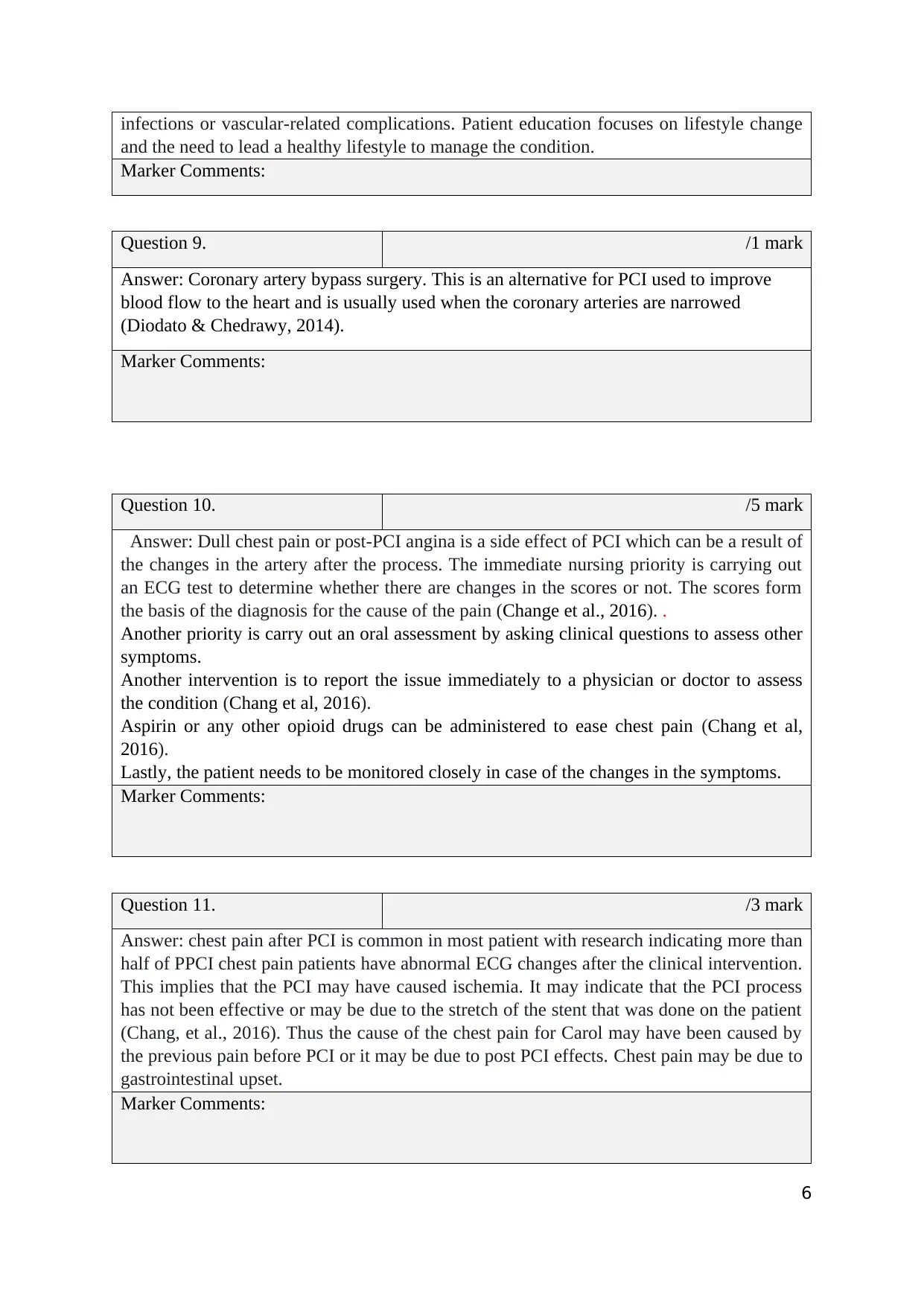
infections or vascular-related complications. Patient education focuses on lifestyle change
and the need to lead a healthy lifestyle to manage the condition.
Marker Comments:
Question 9. /1 mark
Answer: Coronary artery bypass surgery. This is an alternative for PCI used to improve
blood flow to the heart and is usually used when the coronary arteries are narrowed
(Diodato & Chedrawy, 2014).
Marker Comments:
Question 10. /5 mark
Answer: Dull chest pain or post-PCI angina is a side effect of PCI which can be a result of
the changes in the artery after the process. The immediate nursing priority is carrying out
an ECG test to determine whether there are changes in the scores or not. The scores form
the basis of the diagnosis for the cause of the pain (Change et al., 2016). .
Another priority is carry out an oral assessment by asking clinical questions to assess other
symptoms.
Another intervention is to report the issue immediately to a physician or doctor to assess
the condition (Chang et al, 2016).
Aspirin or any other opioid drugs can be administered to ease chest pain (Chang et al,
2016).
Lastly, the patient needs to be monitored closely in case of the changes in the symptoms.
Marker Comments:
Question 11. /3 mark
Answer: chest pain after PCI is common in most patient with research indicating more than
half of PPCI chest pain patients have abnormal ECG changes after the clinical intervention.
This implies that the PCI may have caused ischemia. It may indicate that the PCI process
has not been effective or may be due to the stretch of the stent that was done on the patient
(Chang, et al., 2016). Thus the cause of the chest pain for Carol may have been caused by
the previous pain before PCI or it may be due to post PCI effects. Chest pain may be due to
gastrointestinal upset.
Marker Comments:
6
and the need to lead a healthy lifestyle to manage the condition.
Marker Comments:
Question 9. /1 mark
Answer: Coronary artery bypass surgery. This is an alternative for PCI used to improve
blood flow to the heart and is usually used when the coronary arteries are narrowed
(Diodato & Chedrawy, 2014).
Marker Comments:
Question 10. /5 mark
Answer: Dull chest pain or post-PCI angina is a side effect of PCI which can be a result of
the changes in the artery after the process. The immediate nursing priority is carrying out
an ECG test to determine whether there are changes in the scores or not. The scores form
the basis of the diagnosis for the cause of the pain (Change et al., 2016). .
Another priority is carry out an oral assessment by asking clinical questions to assess other
symptoms.
Another intervention is to report the issue immediately to a physician or doctor to assess
the condition (Chang et al, 2016).
Aspirin or any other opioid drugs can be administered to ease chest pain (Chang et al,
2016).
Lastly, the patient needs to be monitored closely in case of the changes in the symptoms.
Marker Comments:
Question 11. /3 mark
Answer: chest pain after PCI is common in most patient with research indicating more than
half of PPCI chest pain patients have abnormal ECG changes after the clinical intervention.
This implies that the PCI may have caused ischemia. It may indicate that the PCI process
has not been effective or may be due to the stretch of the stent that was done on the patient
(Chang, et al., 2016). Thus the cause of the chest pain for Carol may have been caused by
the previous pain before PCI or it may be due to post PCI effects. Chest pain may be due to
gastrointestinal upset.
Marker Comments:
6
⊘ This is a preview!⊘
Do you want full access?
Subscribe today to unlock all pages.

Trusted by 1+ million students worldwide
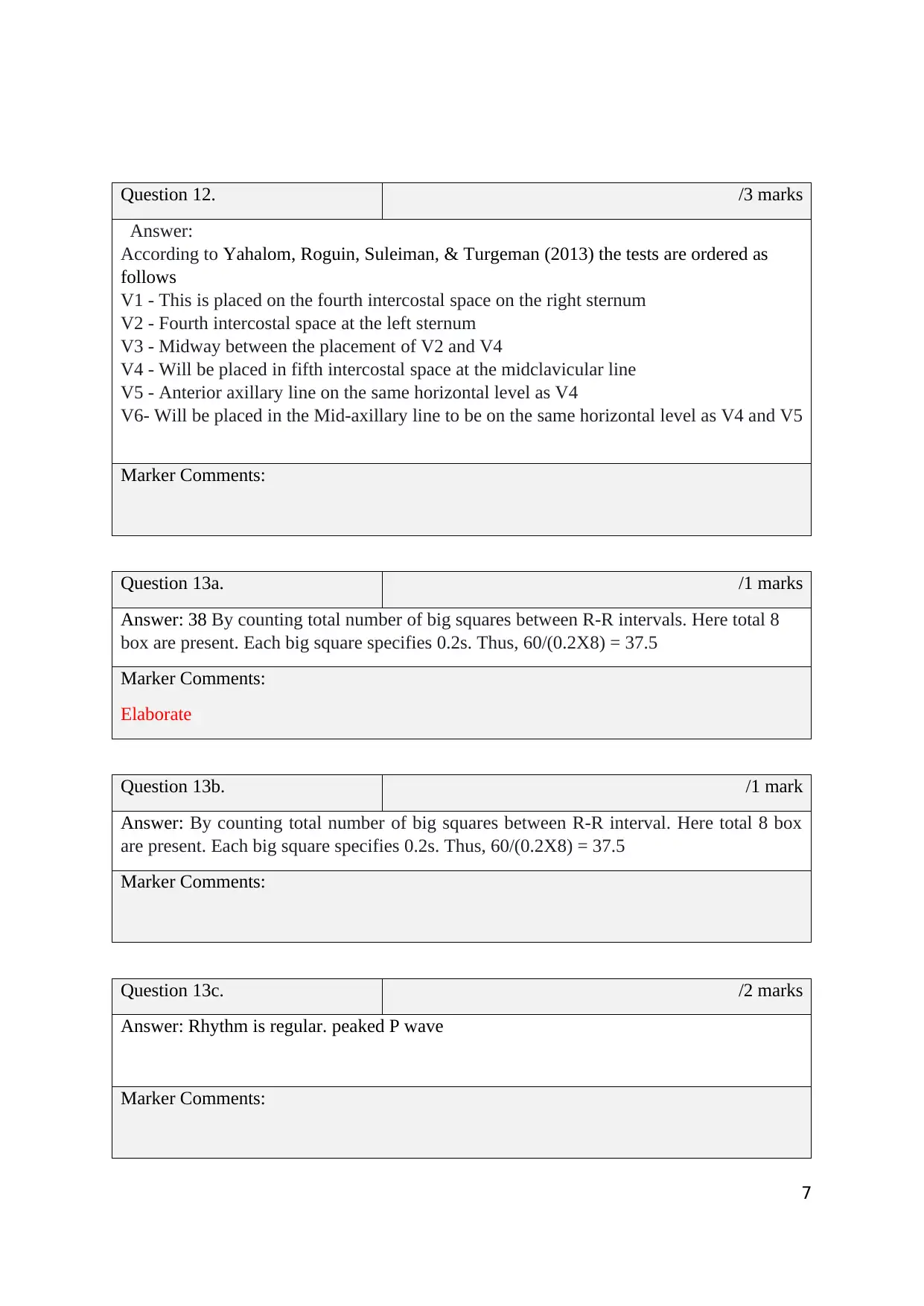
Question 12. /3 marks
Answer:
According to Yahalom, Roguin, Suleiman, & Turgeman (2013) the tests are ordered as
follows
V1 - This is placed on the fourth intercostal space on the right sternum
V2 - Fourth intercostal space at the left sternum
V3 - Midway between the placement of V2 and V4
V4 - Will be placed in fifth intercostal space at the midclavicular line
V5 - Anterior axillary line on the same horizontal level as V4
V6- Will be placed in the Mid-axillary line to be on the same horizontal level as V4 and V5
Marker Comments:
Question 13a. /1 marks
Answer: 38 By counting total number of big squares between R-R intervals. Here total 8
box are present. Each big square specifies 0.2s. Thus, 60/(0.2X8) = 37.5
Marker Comments:
Elaborate
Question 13b. /1 mark
Answer: By counting total number of big squares between R-R interval. Here total 8 box
are present. Each big square specifies 0.2s. Thus, 60/(0.2X8) = 37.5
Marker Comments:
Question 13c. /2 marks
Answer: Rhythm is regular. peaked P wave
Marker Comments:
7
Answer:
According to Yahalom, Roguin, Suleiman, & Turgeman (2013) the tests are ordered as
follows
V1 - This is placed on the fourth intercostal space on the right sternum
V2 - Fourth intercostal space at the left sternum
V3 - Midway between the placement of V2 and V4
V4 - Will be placed in fifth intercostal space at the midclavicular line
V5 - Anterior axillary line on the same horizontal level as V4
V6- Will be placed in the Mid-axillary line to be on the same horizontal level as V4 and V5
Marker Comments:
Question 13a. /1 marks
Answer: 38 By counting total number of big squares between R-R intervals. Here total 8
box are present. Each big square specifies 0.2s. Thus, 60/(0.2X8) = 37.5
Marker Comments:
Elaborate
Question 13b. /1 mark
Answer: By counting total number of big squares between R-R interval. Here total 8 box
are present. Each big square specifies 0.2s. Thus, 60/(0.2X8) = 37.5
Marker Comments:
Question 13c. /2 marks
Answer: Rhythm is regular. peaked P wave
Marker Comments:
7
Paraphrase This Document
Need a fresh take? Get an instant paraphrase of this document with our AI Paraphraser
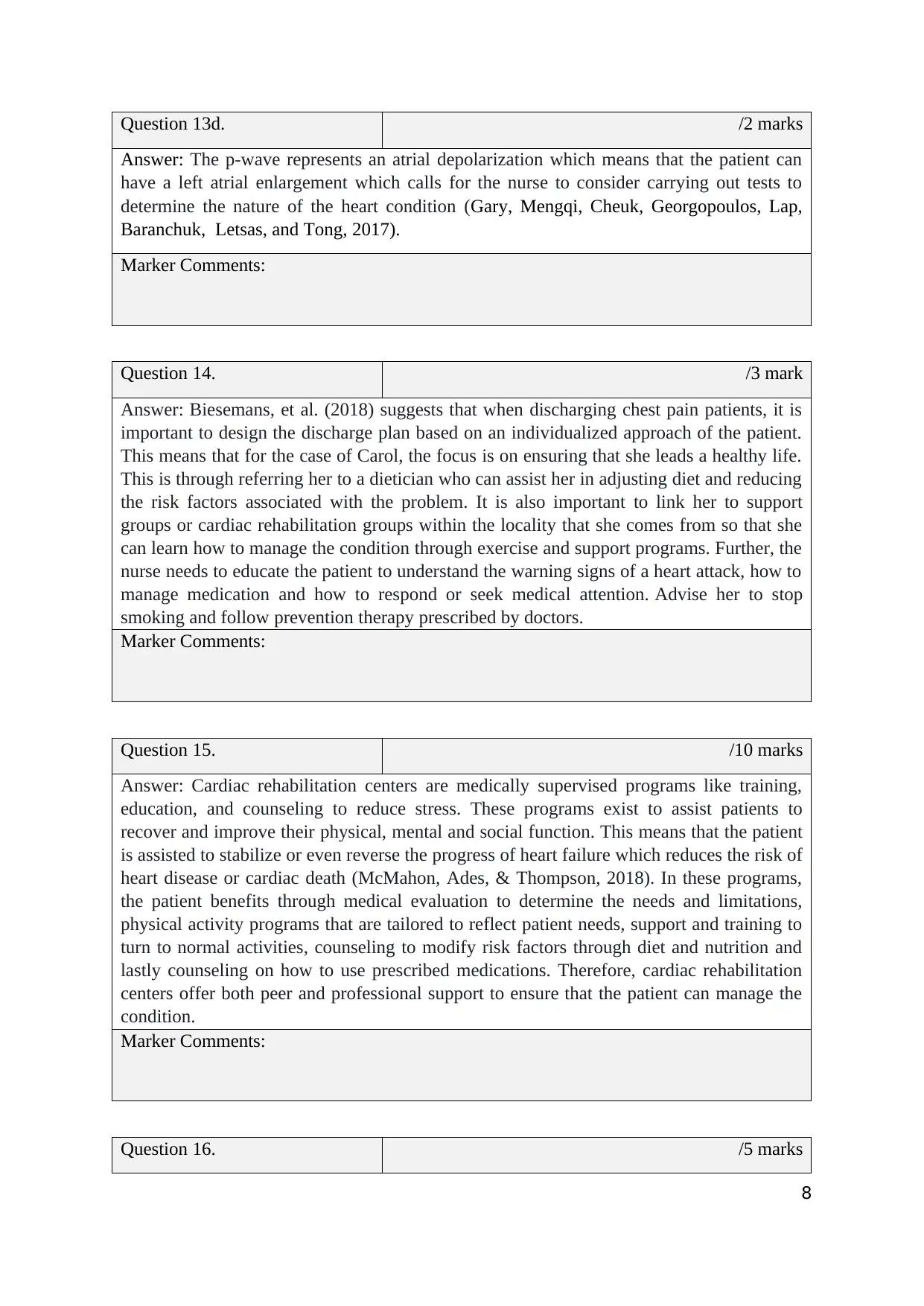
Question 13d. /2 marks
Answer: The p-wave represents an atrial depolarization which means that the patient can
have a left atrial enlargement which calls for the nurse to consider carrying out tests to
determine the nature of the heart condition (Gary, Mengqi, Cheuk, Georgopoulos, Lap,
Baranchuk, Letsas, and Tong, 2017).
Marker Comments:
Question 14. /3 mark
Answer: Biesemans, et al. (2018) suggests that when discharging chest pain patients, it is
important to design the discharge plan based on an individualized approach of the patient.
This means that for the case of Carol, the focus is on ensuring that she leads a healthy life.
This is through referring her to a dietician who can assist her in adjusting diet and reducing
the risk factors associated with the problem. It is also important to link her to support
groups or cardiac rehabilitation groups within the locality that she comes from so that she
can learn how to manage the condition through exercise and support programs. Further, the
nurse needs to educate the patient to understand the warning signs of a heart attack, how to
manage medication and how to respond or seek medical attention. Advise her to stop
smoking and follow prevention therapy prescribed by doctors.
Marker Comments:
Question 15. /10 marks
Answer: Cardiac rehabilitation centers are medically supervised programs like training,
education, and counseling to reduce stress. These programs exist to assist patients to
recover and improve their physical, mental and social function. This means that the patient
is assisted to stabilize or even reverse the progress of heart failure which reduces the risk of
heart disease or cardiac death (McMahon, Ades, & Thompson, 2018). In these programs,
the patient benefits through medical evaluation to determine the needs and limitations,
physical activity programs that are tailored to reflect patient needs, support and training to
turn to normal activities, counseling to modify risk factors through diet and nutrition and
lastly counseling on how to use prescribed medications. Therefore, cardiac rehabilitation
centers offer both peer and professional support to ensure that the patient can manage the
condition.
Marker Comments:
Question 16. /5 marks
8
Answer: The p-wave represents an atrial depolarization which means that the patient can
have a left atrial enlargement which calls for the nurse to consider carrying out tests to
determine the nature of the heart condition (Gary, Mengqi, Cheuk, Georgopoulos, Lap,
Baranchuk, Letsas, and Tong, 2017).
Marker Comments:
Question 14. /3 mark
Answer: Biesemans, et al. (2018) suggests that when discharging chest pain patients, it is
important to design the discharge plan based on an individualized approach of the patient.
This means that for the case of Carol, the focus is on ensuring that she leads a healthy life.
This is through referring her to a dietician who can assist her in adjusting diet and reducing
the risk factors associated with the problem. It is also important to link her to support
groups or cardiac rehabilitation groups within the locality that she comes from so that she
can learn how to manage the condition through exercise and support programs. Further, the
nurse needs to educate the patient to understand the warning signs of a heart attack, how to
manage medication and how to respond or seek medical attention. Advise her to stop
smoking and follow prevention therapy prescribed by doctors.
Marker Comments:
Question 15. /10 marks
Answer: Cardiac rehabilitation centers are medically supervised programs like training,
education, and counseling to reduce stress. These programs exist to assist patients to
recover and improve their physical, mental and social function. This means that the patient
is assisted to stabilize or even reverse the progress of heart failure which reduces the risk of
heart disease or cardiac death (McMahon, Ades, & Thompson, 2018). In these programs,
the patient benefits through medical evaluation to determine the needs and limitations,
physical activity programs that are tailored to reflect patient needs, support and training to
turn to normal activities, counseling to modify risk factors through diet and nutrition and
lastly counseling on how to use prescribed medications. Therefore, cardiac rehabilitation
centers offer both peer and professional support to ensure that the patient can manage the
condition.
Marker Comments:
Question 16. /5 marks
8
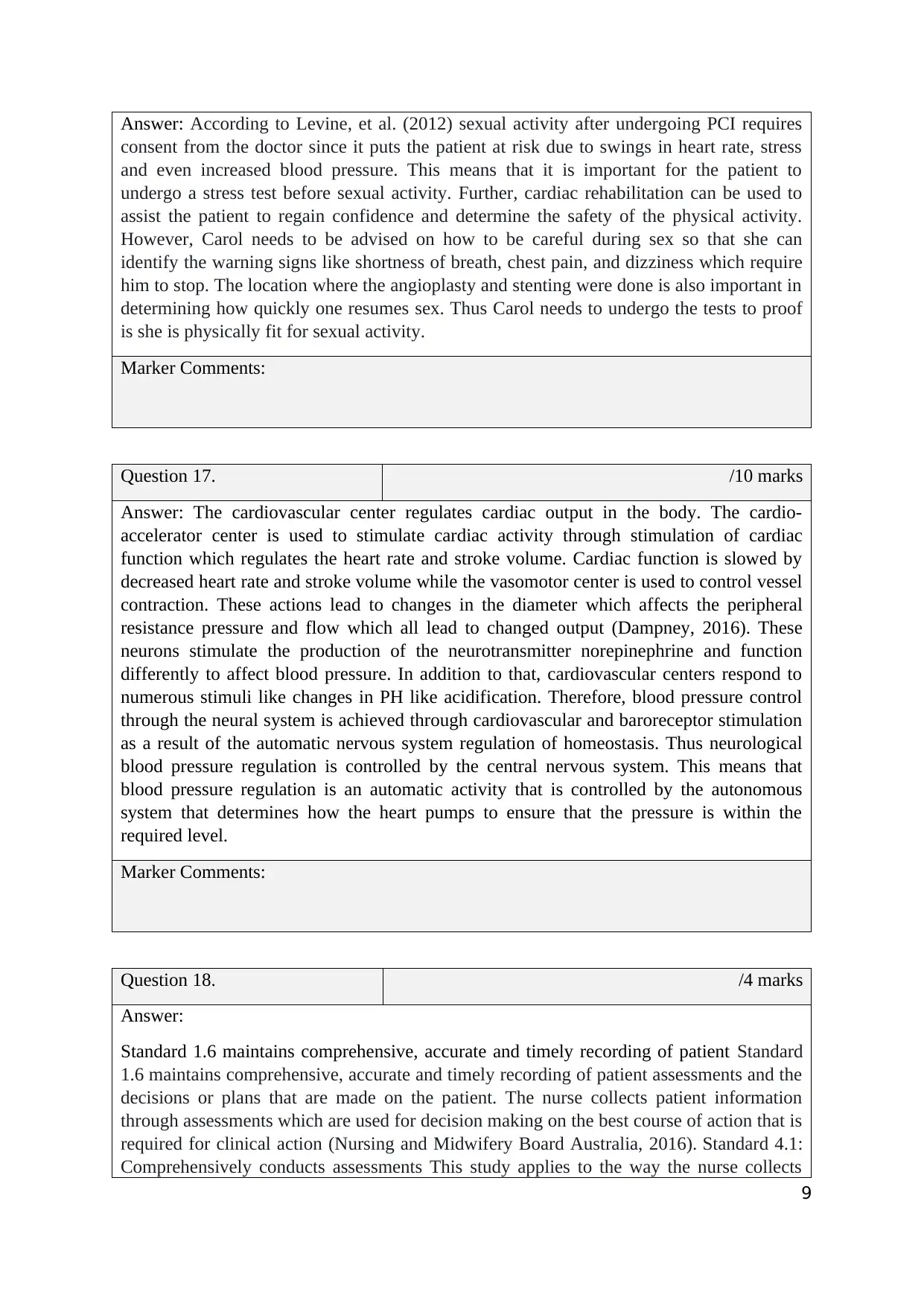
Answer: According to Levine, et al. (2012) sexual activity after undergoing PCI requires
consent from the doctor since it puts the patient at risk due to swings in heart rate, stress
and even increased blood pressure. This means that it is important for the patient to
undergo a stress test before sexual activity. Further, cardiac rehabilitation can be used to
assist the patient to regain confidence and determine the safety of the physical activity.
However, Carol needs to be advised on how to be careful during sex so that she can
identify the warning signs like shortness of breath, chest pain, and dizziness which require
him to stop. The location where the angioplasty and stenting were done is also important in
determining how quickly one resumes sex. Thus Carol needs to undergo the tests to proof
is she is physically fit for sexual activity.
Marker Comments:
Question 17. /10 marks
Answer: The cardiovascular center regulates cardiac output in the body. The cardio-
accelerator center is used to stimulate cardiac activity through stimulation of cardiac
function which regulates the heart rate and stroke volume. Cardiac function is slowed by
decreased heart rate and stroke volume while the vasomotor center is used to control vessel
contraction. These actions lead to changes in the diameter which affects the peripheral
resistance pressure and flow which all lead to changed output (Dampney, 2016). These
neurons stimulate the production of the neurotransmitter norepinephrine and function
differently to affect blood pressure. In addition to that, cardiovascular centers respond to
numerous stimuli like changes in PH like acidification. Therefore, blood pressure control
through the neural system is achieved through cardiovascular and baroreceptor stimulation
as a result of the automatic nervous system regulation of homeostasis. Thus neurological
blood pressure regulation is controlled by the central nervous system. This means that
blood pressure regulation is an automatic activity that is controlled by the autonomous
system that determines how the heart pumps to ensure that the pressure is within the
required level.
Marker Comments:
Question 18. /4 marks
Answer:
Standard 1.6 maintains comprehensive, accurate and timely recording of patient Standard
1.6 maintains comprehensive, accurate and timely recording of patient assessments and the
decisions or plans that are made on the patient. The nurse collects patient information
through assessments which are used for decision making on the best course of action that is
required for clinical action (Nursing and Midwifery Board Australia, 2016). Standard 4.1:
Comprehensively conducts assessments This study applies to the way the nurse collects
9
consent from the doctor since it puts the patient at risk due to swings in heart rate, stress
and even increased blood pressure. This means that it is important for the patient to
undergo a stress test before sexual activity. Further, cardiac rehabilitation can be used to
assist the patient to regain confidence and determine the safety of the physical activity.
However, Carol needs to be advised on how to be careful during sex so that she can
identify the warning signs like shortness of breath, chest pain, and dizziness which require
him to stop. The location where the angioplasty and stenting were done is also important in
determining how quickly one resumes sex. Thus Carol needs to undergo the tests to proof
is she is physically fit for sexual activity.
Marker Comments:
Question 17. /10 marks
Answer: The cardiovascular center regulates cardiac output in the body. The cardio-
accelerator center is used to stimulate cardiac activity through stimulation of cardiac
function which regulates the heart rate and stroke volume. Cardiac function is slowed by
decreased heart rate and stroke volume while the vasomotor center is used to control vessel
contraction. These actions lead to changes in the diameter which affects the peripheral
resistance pressure and flow which all lead to changed output (Dampney, 2016). These
neurons stimulate the production of the neurotransmitter norepinephrine and function
differently to affect blood pressure. In addition to that, cardiovascular centers respond to
numerous stimuli like changes in PH like acidification. Therefore, blood pressure control
through the neural system is achieved through cardiovascular and baroreceptor stimulation
as a result of the automatic nervous system regulation of homeostasis. Thus neurological
blood pressure regulation is controlled by the central nervous system. This means that
blood pressure regulation is an automatic activity that is controlled by the autonomous
system that determines how the heart pumps to ensure that the pressure is within the
required level.
Marker Comments:
Question 18. /4 marks
Answer:
Standard 1.6 maintains comprehensive, accurate and timely recording of patient Standard
1.6 maintains comprehensive, accurate and timely recording of patient assessments and the
decisions or plans that are made on the patient. The nurse collects patient information
through assessments which are used for decision making on the best course of action that is
required for clinical action (Nursing and Midwifery Board Australia, 2016). Standard 4.1:
Comprehensively conducts assessments This study applies to the way the nurse collects
9
⊘ This is a preview!⊘
Do you want full access?
Subscribe today to unlock all pages.

Trusted by 1+ million students worldwide
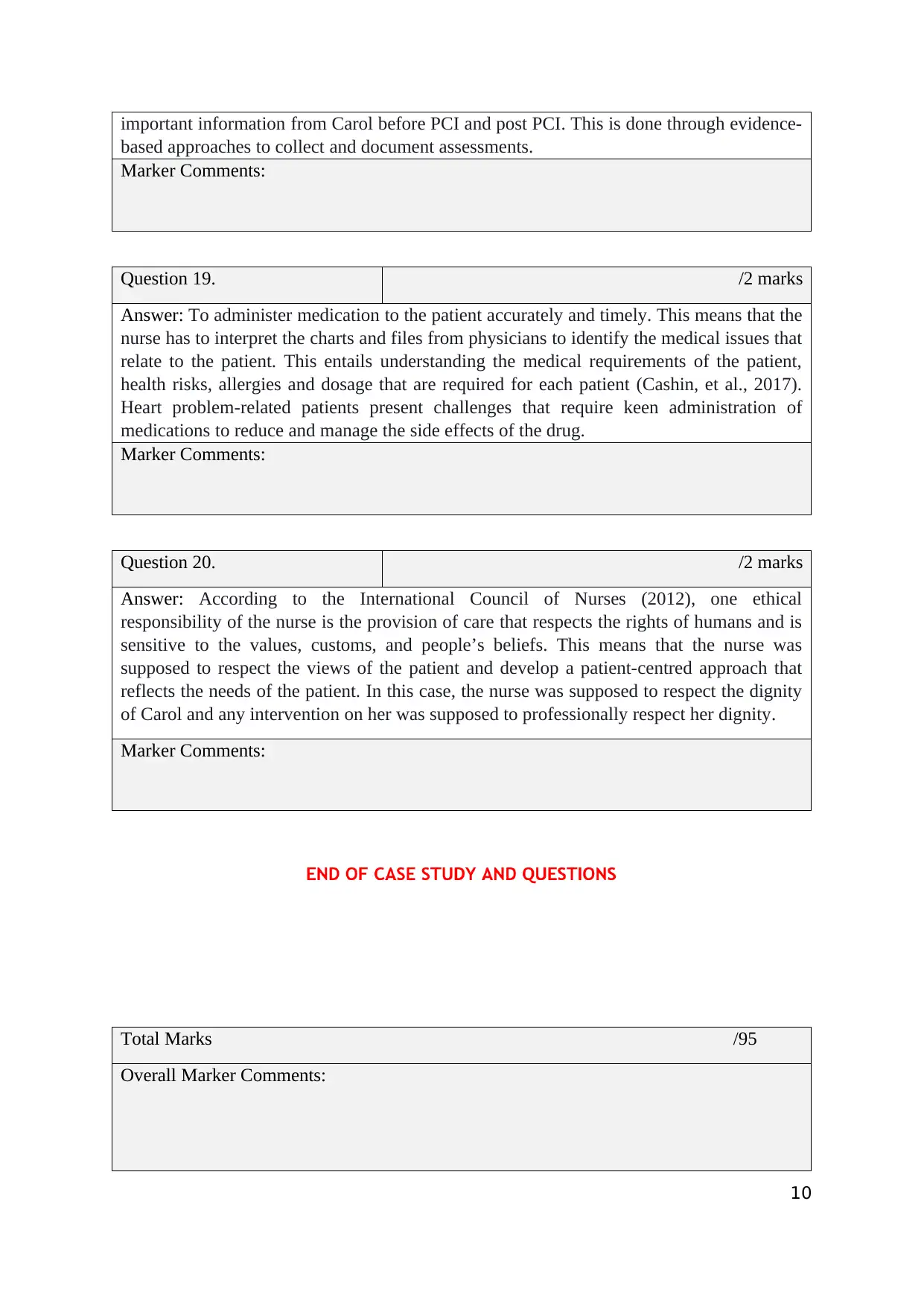
important information from Carol before PCI and post PCI. This is done through evidence-
based approaches to collect and document assessments.
Marker Comments:
Question 19. /2 marks
Answer: To administer medication to the patient accurately and timely. This means that the
nurse has to interpret the charts and files from physicians to identify the medical issues that
relate to the patient. This entails understanding the medical requirements of the patient,
health risks, allergies and dosage that are required for each patient (Cashin, et al., 2017).
Heart problem-related patients present challenges that require keen administration of
medications to reduce and manage the side effects of the drug.
Marker Comments:
Question 20. /2 marks
Answer: According to the International Council of Nurses (2012), one ethical
responsibility of the nurse is the provision of care that respects the rights of humans and is
sensitive to the values, customs, and people’s beliefs. This means that the nurse was
supposed to respect the views of the patient and develop a patient-centred approach that
reflects the needs of the patient. In this case, the nurse was supposed to respect the dignity
of Carol and any intervention on her was supposed to professionally respect her dignity.
Marker Comments:
Total Marks /95
Overall Marker Comments:
10
based approaches to collect and document assessments.
Marker Comments:
Question 19. /2 marks
Answer: To administer medication to the patient accurately and timely. This means that the
nurse has to interpret the charts and files from physicians to identify the medical issues that
relate to the patient. This entails understanding the medical requirements of the patient,
health risks, allergies and dosage that are required for each patient (Cashin, et al., 2017).
Heart problem-related patients present challenges that require keen administration of
medications to reduce and manage the side effects of the drug.
Marker Comments:
Question 20. /2 marks
Answer: According to the International Council of Nurses (2012), one ethical
responsibility of the nurse is the provision of care that respects the rights of humans and is
sensitive to the values, customs, and people’s beliefs. This means that the nurse was
supposed to respect the views of the patient and develop a patient-centred approach that
reflects the needs of the patient. In this case, the nurse was supposed to respect the dignity
of Carol and any intervention on her was supposed to professionally respect her dignity.
Marker Comments:
Total Marks /95
Overall Marker Comments:
10
Paraphrase This Document
Need a fresh take? Get an instant paraphrase of this document with our AI Paraphraser
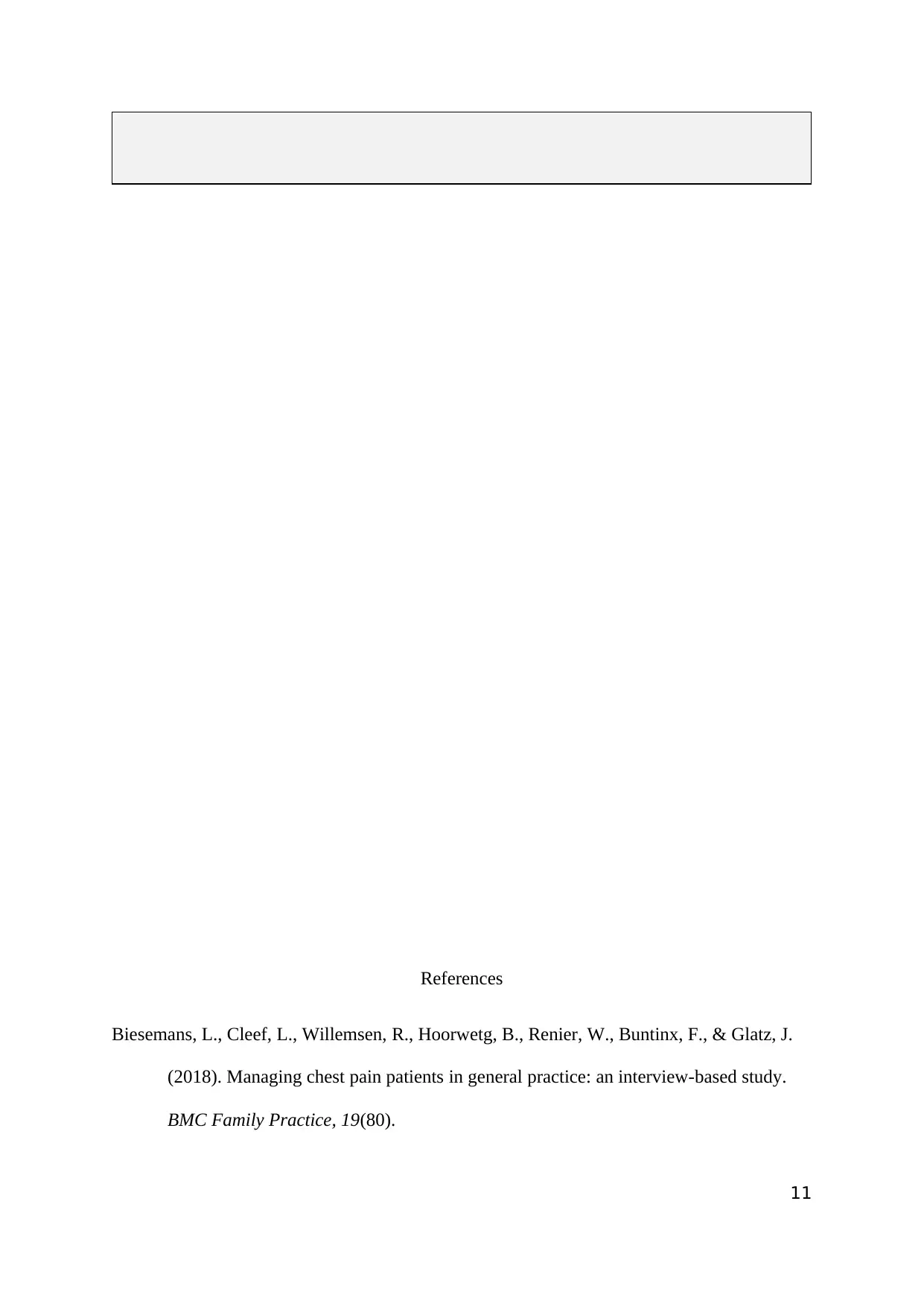
References
Biesemans, L., Cleef, L., Willemsen, R., Hoorwetg, B., Renier, W., Buntinx, F., & Glatz, J.
(2018). Managing chest pain patients in general practice: an interview-based study.
BMC Family Practice, 19(80).
11
Biesemans, L., Cleef, L., Willemsen, R., Hoorwetg, B., Renier, W., Buntinx, F., & Glatz, J.
(2018). Managing chest pain patients in general practice: an interview-based study.
BMC Family Practice, 19(80).
11
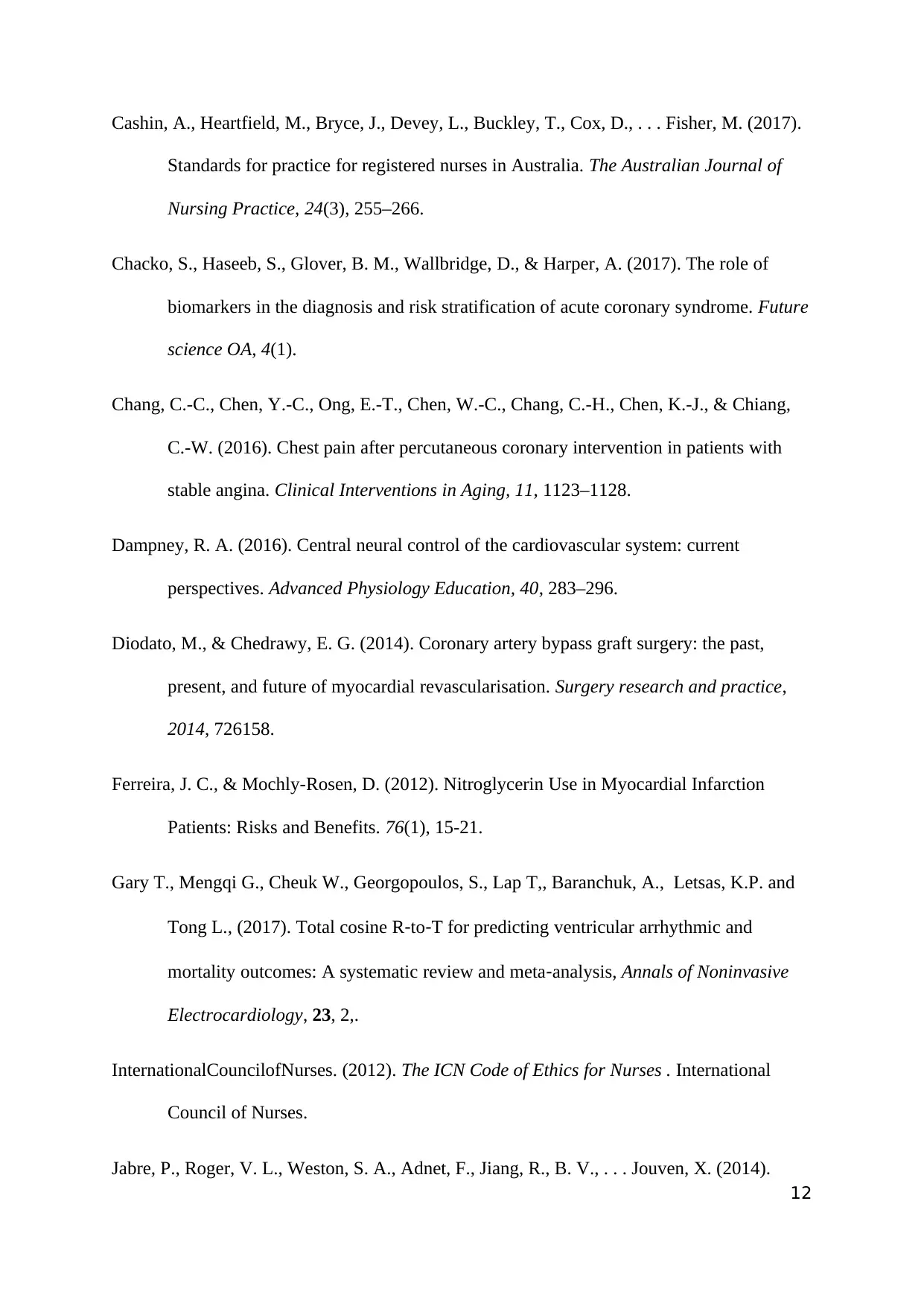
Cashin, A., Heartfield, M., Bryce, J., Devey, L., Buckley, T., Cox, D., . . . Fisher, M. (2017).
Standards for practice for registered nurses in Australia. The Australian Journal of
Nursing Practice, 24(3), 255–266.
Chacko, S., Haseeb, S., Glover, B. M., Wallbridge, D., & Harper, A. (2017). The role of
biomarkers in the diagnosis and risk stratification of acute coronary syndrome. Future
science OA, 4(1).
Chang, C.-C., Chen, Y.-C., Ong, E.-T., Chen, W.-C., Chang, C.-H., Chen, K.-J., & Chiang,
C.-W. (2016). Chest pain after percutaneous coronary intervention in patients with
stable angina. Clinical Interventions in Aging, 11, 1123–1128.
Dampney, R. A. (2016). Central neural control of the cardiovascular system: current
perspectives. Advanced Physiology Education, 40, 283–296.
Diodato, M., & Chedrawy, E. G. (2014). Coronary artery bypass graft surgery: the past,
present, and future of myocardial revascularisation. Surgery research and practice,
2014, 726158.
Ferreira, J. C., & Mochly-Rosen, D. (2012). Nitroglycerin Use in Myocardial Infarction
Patients: Risks and Benefits. 76(1), 15-21.
Gary T., Mengqi G., Cheuk W., Georgopoulos, S., Lap T,, Baranchuk, A., Letsas, K.P. and
Tong L., (2017). Total cosine R‐to‐T for predicting ventricular arrhythmic and
mortality outcomes: A systematic review and meta‐analysis, Annals of Noninvasive
Electrocardiology, 23, 2,.
InternationalCouncilofNurses. (2012). The ICN Code of Ethics for Nurses . International
Council of Nurses.
Jabre, P., Roger, V. L., Weston, S. A., Adnet, F., Jiang, R., B. V., . . . Jouven, X. (2014).
12
Standards for practice for registered nurses in Australia. The Australian Journal of
Nursing Practice, 24(3), 255–266.
Chacko, S., Haseeb, S., Glover, B. M., Wallbridge, D., & Harper, A. (2017). The role of
biomarkers in the diagnosis and risk stratification of acute coronary syndrome. Future
science OA, 4(1).
Chang, C.-C., Chen, Y.-C., Ong, E.-T., Chen, W.-C., Chang, C.-H., Chen, K.-J., & Chiang,
C.-W. (2016). Chest pain after percutaneous coronary intervention in patients with
stable angina. Clinical Interventions in Aging, 11, 1123–1128.
Dampney, R. A. (2016). Central neural control of the cardiovascular system: current
perspectives. Advanced Physiology Education, 40, 283–296.
Diodato, M., & Chedrawy, E. G. (2014). Coronary artery bypass graft surgery: the past,
present, and future of myocardial revascularisation. Surgery research and practice,
2014, 726158.
Ferreira, J. C., & Mochly-Rosen, D. (2012). Nitroglycerin Use in Myocardial Infarction
Patients: Risks and Benefits. 76(1), 15-21.
Gary T., Mengqi G., Cheuk W., Georgopoulos, S., Lap T,, Baranchuk, A., Letsas, K.P. and
Tong L., (2017). Total cosine R‐to‐T for predicting ventricular arrhythmic and
mortality outcomes: A systematic review and meta‐analysis, Annals of Noninvasive
Electrocardiology, 23, 2,.
InternationalCouncilofNurses. (2012). The ICN Code of Ethics for Nurses . International
Council of Nurses.
Jabre, P., Roger, V. L., Weston, S. A., Adnet, F., Jiang, R., B. V., . . . Jouven, X. (2014).
12
⊘ This is a preview!⊘
Do you want full access?
Subscribe today to unlock all pages.

Trusted by 1+ million students worldwide
1 out of 14
Related Documents
Your All-in-One AI-Powered Toolkit for Academic Success.
+13062052269
info@desklib.com
Available 24*7 on WhatsApp / Email
![[object Object]](/_next/static/media/star-bottom.7253800d.svg)
Unlock your academic potential
Copyright © 2020–2025 A2Z Services. All Rights Reserved. Developed and managed by ZUCOL.



